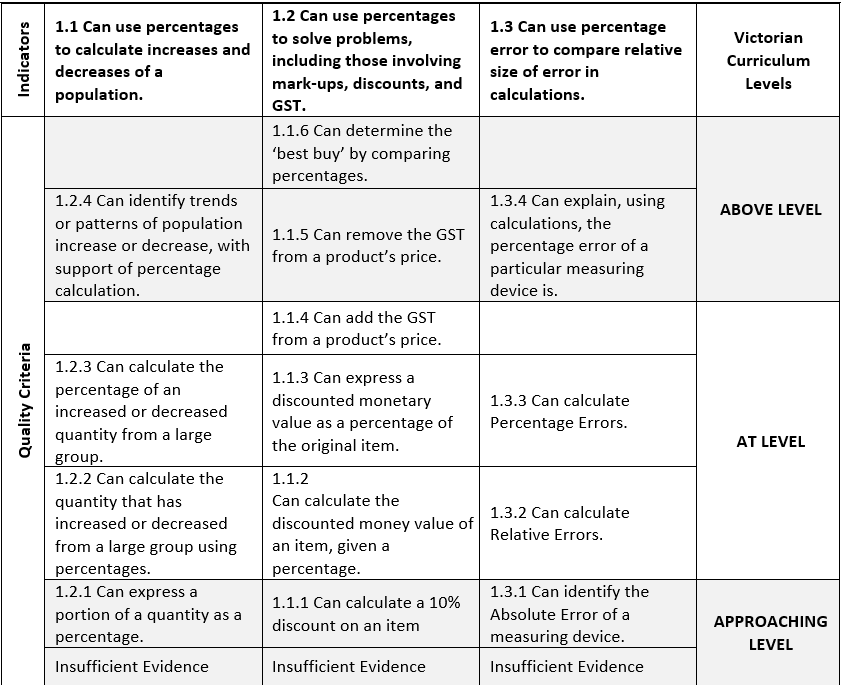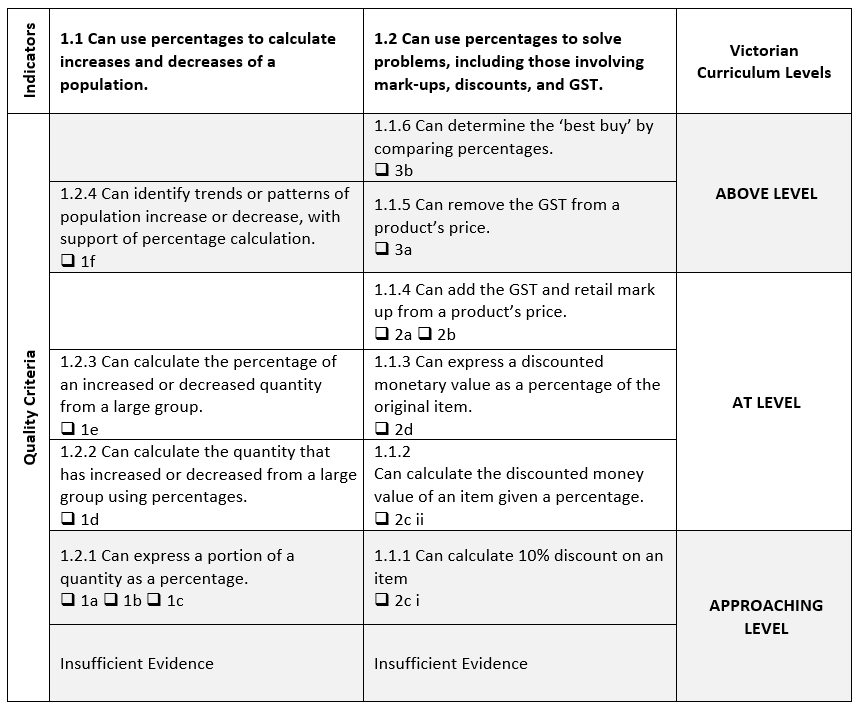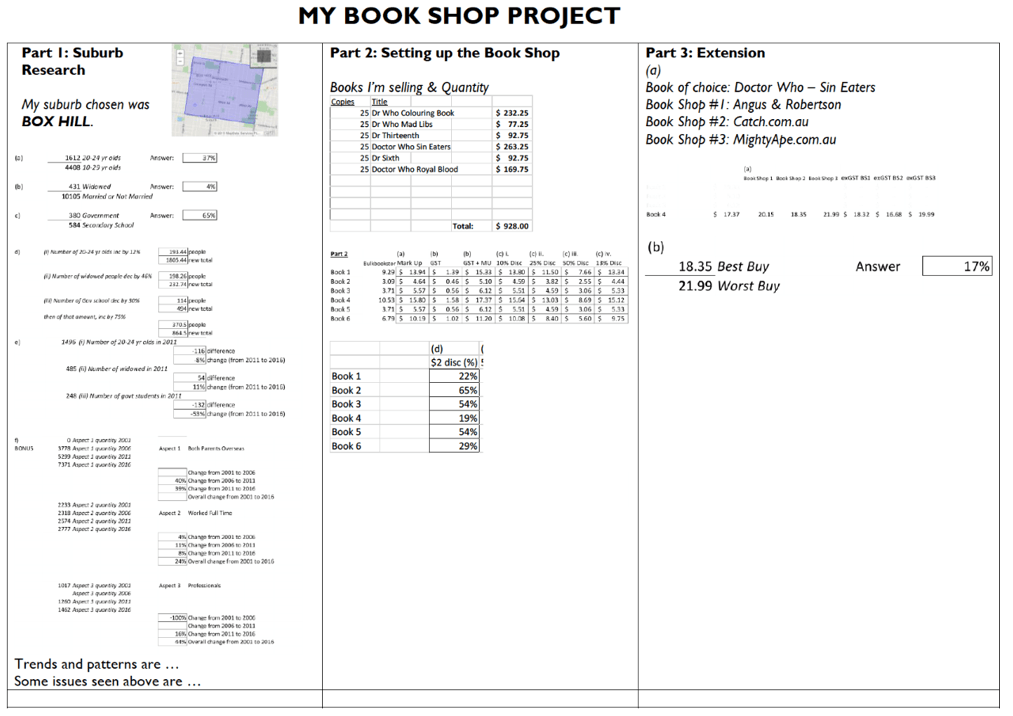
By David Innes
EDITION #6 – “How do I take responsibility for my own performance?”
Published – 26th June 2019

David Innes is currently a Learning Specialist at Box Hill High School. He has taught for ten years in Mathematics, Science and Chemistry. He has delivered professional development sessions for the Teacher Learning Network. David has performed for the Melbourne International Comedy Festival for many years and has run an improvisational theatre troupe. David is passionate about finding new and better ways to explain concepts and to encourage students to have a better experience with mathematics.
When marking, teachers will generally refer to a marking scheme that’s either self-made or created by a colleague. Usually, this is the end of the moderation process for a majority of assessments, as there is very little time outside of class to spend comparing student work. In the pile of marking, there will inevitably be a collection of submissions that do not adhere conveniently to the scheme. Teachers will then engage in ‘social moderation’ (Meirs et al, 2007), which often involves asking a colleague ‘what they think’ about a student’s work. Once consensus has been met, the work has been marked. This can be effective if the teaching team of a subject is small. If the teaching team is large, with varying levels of experience, there can still be large discrepancies between marks. To minimise the ‘argy-bargy’ that occurs with moderation between a large group of teachers and the level of discrepancy, it is recommended that a developmental rubric approach be taken prior to beginning the unit.
The Developmental Rubric
A developmental rubric is an assessment guide that covers the expected learning of a student in a particular unit. The rubric is formed and agreed upon by the teaching team by using the standards Victorian Curriculum F-10 Assessment Standards, grouped by indicators developed from the Curriculum Elaborations. This work ideally should be completed prior to the beginning of the year or during Curriculum Planning days.
Solve problems involving the use of percentages, including percentage increases and decreases and percentage error, with and without digital technologies (VCMNA276)

Table 1: A sample of a developmental rubric on the topic of “Application of Percentage” for Year 8 Mathematics.
In Table 1, the indicators reference the different aspects of the Victorian Curriculum F-10 statement in the title. These have been adapted from the Elaborations that are provided in the curriculum. Underneath each aspect there is an ‘I Can’ statement to match a student’s ability. It is essential that each ‘I Can’ statement is measurable and only refers to one action. For example, for a student to be ‘At Level’ at Year 8, they should be able to calculate a discount from a product’s price, both as a percentage and as a monetary value and also add GST to a product. If that statement was listed as one Quality Criteria, it would become subjective to measure – have they achieved ‘two-thirds’ of a criterion? By breaking up that statement into separate criteria, the students’ learning is much easier to visualise and provides a better diagnosis for what appears to be the issue in the students’ understanding.
Developing the Assessment
Once a rubric is agreed upon by the teaching team, an assessment can be made. Topics can be very large and having one assessment that covers all aspects can be intimidating for students and unwieldy to assess for teachers. Therefore, the team decides which indicators will be assessed and by what means. In the example listed above, Indicator 1.3 was assessed using a simple worksheet of four questions covering Percentage Error. Students met the criteria if they got the questions correct. Indicators 1.1 and 1.2 were assessed as part of a larger assignment. Below is an excerpt from this assignment.
Pop Up Book Shop Project
You are going to start up a pop-up bookshop in a new suburb. It will be a specialty bookshop that stocks the kind of books that you want to sell. But first, you will need to do some research into your location as to where you are selling them.
NOTE: You must show your working at all times. Round all percentages to 2 decimal places.
Part #1: Suburb Investigation
- You will be allocated a suburb by your teacher. No two students can do the same suburb.
- Go to http://www.abs.gov.au/census
- Then type in your suburb under “QuickStats” Search. Make sure it says “Vic” for Victoria and “State Suburb” underneath. Keep the option on 2016 for now.
- Out of the people who are between 10 and 29 inclusive, state, as a percentage, how many people are between 20 and 24.
- Out of the people who are neither Married nor Not Married, express as a percentage, the people who are widowed.
- Out of those who are attending a Secondary Education institution, express as a percentage the people who are in a Government school.
- Using your answers from (a), (b) and (c) calculate the quantity of people if the:
- 20 and 24 year olds increased by 12%
- number of widowed people decreased by 46%
- number of people who went to a Government School decreased by 30%. Then, afterwards, if that reduced group then increased by 75%.
- Find the Census Data from 2011. Express, as a percentage, the change in number of:
- 20 to 24 years old.
- Number of widowed people
- Government school secondary students
EXTENSION (optional): Now look up the 2016, 2011, 2006 and 2001 Census summaries for your suburb. Pick three aspects of the Census Data to investigate over the 15 years (e.g. number of people unemployed, the number of people living in the suburb, the number of widowed people) State the trend or pattern for each of the three aspects (e.g. has the unemployment increased over time?). Provide evidence of a trend by calculating the percentage change of that aspect from year to year.

Part #2: The pop-up shop
- You have $1000 to buy your first lot of books to sell at the shop.
- Go to: https://bulkbookstore.com
- For the purposes of this assignment, let us assume all the prices are in Australian Dollars.
- Choose what books you will sell. As per the ‘Bulk Bookstore’ policy, you need to buy a minimum of 25 per item.
- List what the individual mark up on each book would be. Mark up would be the selling price plus an extra fifty percent.
- GST is an extra 10% on top of the selling price you calculated in (a). Calculate the GST for each one.
- Customers will pester you at some point about getting a discount on the books in the shop. Calculate how much money each of the following discounts (on the price calculated in (b)) would result for each item:
- 10%
- 13%
- As a promotion, you give out a $2 off gift voucher as part of a letter box drop in your suburb. Calculate how much of a discount that would result in for each of your items.
Part #3 (Extension Optional): Smarter Buys
Choose a different book from the one you investigated in Part 2 (h). Investigate three (3) different places you can purchase this book. A ‘best buy’ is a product that is the best value for money (e.g. cheapest). A ‘worst buy’ is the opposite (e.g. most expensive)
- In each of the different options you researched, assume GST has been put on each one. Remove the GST on each item.
- Which of the three options is the ‘best buy’? Support your answer by calculating it as a percentage difference from the ‘worst buy’.
The questions were written based on the rubric that was outlined. Each quality criteria has at least one question assigned to it. It is my belief that all assessment tasks should have an opportunity for students to show if they are Above Standard, but I do not believe it to be mandatory.

Table 2: The rubric with the quality criteria matched with the questions in the task.
Having a clear marking rubric is essential for any assessment and all members of the teaching team should fully understand it prior to beginning the assessment (Shapland, 2011). Once the rubric and the assessment have been designed, a sample work should be created.
Sample Work
A student sample is both useful to staff and students (High Impact Teaching Strategies, 4- Worked Examples). Whilst you do not want to hold the students’ hand and tell them all the answers, giving them a model of how their assignment should look saves anxiety and stress and losing marks unnecessarily. For the teaching team, if all teachers have the same expectation as to what the student work should look like, this prevents high quality work to be assessed as being low or vice versa. For this assignment, it is clear in the instructions that working out has to be shown. In this assignment, working out is written on the back of the poster.

Figure 1: The sample provided for the Book Shop project.
For questions where an explanation is required, a sample response is emailed to the teaching team. In this sample, students list values and then write a sentence underneath that explain the trends or patterns found. Teachers also know then that to award marks for this question, they must have both percentages and a sentence explanation.
Grades or Skills?
There is a trend to move away from traditional numerical grades in F-10 as students and parents tend to focus solely on the final letter grade, rather than what the student has learned. To combat this, teachers often spend a lot of time marking, providing a grade and then adding copious comments that also, unfortunately, tend to get ignored. Having this developmental rubric means students know exactly what they know and do not know. Moving away from traditional letter grades also encourages a growth mindset, rather than a performance mindset, where students can specifically identify what they have learned and what they need to work on.
By providing a developmental rubric, an assignment closely aligned to this scheme and sample work, there is an increased likelihood that students are taught the same material and assessed in the same way. How the material is taught and implemented is entirely up to that teacher’s individual character and flair, as it ought to be. There is no call for robotic, ‘one-size-fits-all’ teachers, only for fairness amongst all students.
Further reading
The benefits of moderation are many and the DET has some helpful resources that can assist teachers in continuing to grow in this area:
Teacher Tip: Use moderation to make consistent decisions about student learning and assessment contains a step-by-step guide to moderating.
Professional Practice Note #15: Assessment Moderation outlines the purpose of moderation as well as some very practical advice for successful moderating.
A case study on Hume Central Secondary College shares the use of a two-part moderation process; to both plan teaching and learning cycles as well as evaluate their effectiveness.
The VCAA Guide to Formative Assessment Rubrics describes the process of describing a learning continuum, developing a formative assessment rubric and then using evidence of student learning to plan for teaching and learning.
References:
Meirs, M, Ozolins, C and McKenzie P (2007) “Improving Consistency in Teacher Judgements: An investigation for the Department of Education, Victoria”. Australian Council for Education Research. https://research.acer.edu.au/cgi/viewcontent.cgi?article=1020&context=tll_misc
Shapland, N (2011) “Assessment Matters! Top 10 Tips for Marking Assessment Items”. Griffith University. https://app.griffith.edu.au/assessment-matters/pdfs/Top10Tips-Marking.pdf
Department of Education and Training. (2017). High impact teaching strategies: Excellence in teaching and learning. Melbourne: State of Victoria. http://www.education.vic.gov.au/Documents/school/teachers/support/highimpactteachstrat.pdf